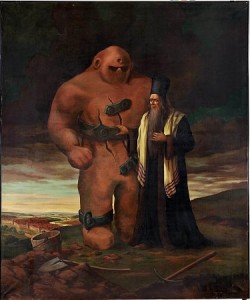Tucked away in the Jewish quarter of Prague is a synagogue that is as beautiful as it is old and significant.
This is the famous Old New Synagogue, Europe’s oldest active synagogue. Completed in 1270, it was one of Prague’s first Gothic buildings. It is said that the body of Golem lies in the attic of this synagogue. Strangely, this building was spared by the Nazis during their destruction of Jewish buildings during the occupation of the city.
The word ‘golem’ means ‘unformed, amorphous’. According to the Talmud (Tractate Sanhedrin 38b), it is the matter which God shaped into the form of Adam, before breathing the breath of life into his nostrils. However, just as God cannot create another God, no man can create another man. Thus a golem made by a man lacks some characteristic or the other which prevents him from being called a man; this is usually the power of speech. The Sefer Yetzirah, the Book of Creation (2nd century BC), says that the letters of the Hebrew alphabet hold the key to creation, and thus it is the interplay of letters which creates and destroys a golem. The word emet (אמת, “truth” in the Hebrew language), inscribed on the head of the golem, keeps it alive. When the golem needs to be deactivated, the letter aleph in emet is erased, changing emet אמת (truth) to met אמ (death). Other legends state that a golem can be controlled by writing a specific series of letters on parchment and placing the paper in the golem’s mouth.
The most famous Golem narrative in history is the one involving Judah Loew ben Bezalel, the 16th century chief rabbi of the city of Prague in Bohemia, widely known as the Maharal of Prague. The Maharal was a well-known Talmudic scholar, mystic and philosopher.
Under the rule of Rudolf II, the Holy Roman Emperor, a decision was taken to kill or expel the Jews of Prague. The Maharal then created the Golem from clay taken from the banks of the Vltava river. Initially successful in its mission, the Golem grew and bacame increasingly violent, killing gentiles and, according to some accounts, Jews too. The Emperor then pleaded to the Maharal to deactivate the Golem, which the latter did. The body of the golem was then stored in the attic of the Old New Synagogue of Prague, where legend says it lies to this day. One tale tells of a Nazi agent who ascended the attic and tried to stab the Golem, but died instead.
Rabbi Menachem Mendel Schneerson (the last Rebbe of Lubavitch) wrote that his father-in-law told him that he saw the remains of the Golem in the attic of Alt-Neu Shul.
Isaac Bashevis Singer said that the golem is the “very essence of Jewish folklore”. Yet this enthralling legend has strayed far beyond the realm of Jewish myth and strayed into the silver screen, Marvel comics, the opera, ballets, and plays.
Gustav Meyrink’s 1914 novel Der Golem is loosely inspired by the tales of the golem created by Judah Loew ben Bezalel.
In 1974, Marvel Comics introduced “The Golem” as a recurring character in its Strange Tales comic book series.
David Brin’s science-fiction novel, Kiln People, describes a future where humans make lower quality copies of themselves (dittos or golems) out of clay. After reaching their expiration date, the golem’s memories can be reintegrated to the original person.
Two episodes of the science fiction TV series The X-Files, season 4’s Kaddish and season 6’s Arcadia, feature golems.
In I, Robot, Isaac Asimov shows us robots growing in sophistication and approaching ever nearer to humans in their consciousness. But the robot never attains humanity, just as man never attains godhead. Like a robot, the golem can always be destroyed by its maker, since it has no soul.
The golem is a popular figure in the Czech Republic. There are several restaurants and other businesses whose names reference the creature.
Golem of Prague: Fact or Fiction?
This lecture was given at The Intercontinental Hotel in Vienna by Dr Shnayer Leiman on July 7, 2009.
Download the lecture here
This is the famous Old New Synagogue, Europe’s oldest active synagogue. Completed in 1270, it was one of Prague’s first Gothic buildings. It is said that the body of Golem lies in the attic of this synagogue. Strangely, this building was spared by the Nazis during their destruction of Jewish buildings during the occupation of the city.
The word ‘golem’ means ‘unformed, amorphous’. According to the Talmud (Tractate Sanhedrin 38b), it is the matter which God shaped into the form of Adam, before breathing the breath of life into his nostrils. However, just as God cannot create another God, no man can create another man. Thus a golem made by a man lacks some characteristic or the other which prevents him from being called a man; this is usually the power of speech. The Sefer Yetzirah, the Book of Creation (2nd century BC), says that the letters of the Hebrew alphabet hold the key to creation, and thus it is the interplay of letters which creates and destroys a golem. The word emet (אמת, “truth” in the Hebrew language), inscribed on the head of the golem, keeps it alive. When the golem needs to be deactivated, the letter aleph in emet is erased, changing emet אמת (truth) to met אמ (death). Other legends state that a golem can be controlled by writing a specific series of letters on parchment and placing the paper in the golem’s mouth.
The most famous Golem narrative in history is the one involving Judah Loew ben Bezalel, the 16th century chief rabbi of the city of Prague in Bohemia, widely known as the Maharal of Prague. The Maharal was a well-known Talmudic scholar, mystic and philosopher.
 |
Tombstone of the Maharal, at the Old Jewish Cemetery, Prague |
 |
| Illustration of a golem, by Philippe Semeria |
Isaac Bashevis Singer said that the golem is the “very essence of Jewish folklore”. Yet this enthralling legend has strayed far beyond the realm of Jewish myth and strayed into the silver screen, Marvel comics, the opera, ballets, and plays.
Gustav Meyrink’s 1914 novel Der Golem is loosely inspired by the tales of the golem created by Judah Loew ben Bezalel.
 |
| The golem and the rabbi |
David Brin’s science-fiction novel, Kiln People, describes a future where humans make lower quality copies of themselves (dittos or golems) out of clay. After reaching their expiration date, the golem’s memories can be reintegrated to the original person.
Two episodes of the science fiction TV series The X-Files, season 4’s Kaddish and season 6’s Arcadia, feature golems.
In I, Robot, Isaac Asimov shows us robots growing in sophistication and approaching ever nearer to humans in their consciousness. But the robot never attains humanity, just as man never attains godhead. Like a robot, the golem can always be destroyed by its maker, since it has no soul.
The golem is a popular figure in the Czech Republic. There are several restaurants and other businesses whose names reference the creature.
Golem of Prague: Fact or Fiction?
This lecture was given at The Intercontinental Hotel in Vienna by Dr Shnayer Leiman on July 7, 2009.
Download the lecture here

No comments:
Post a Comment